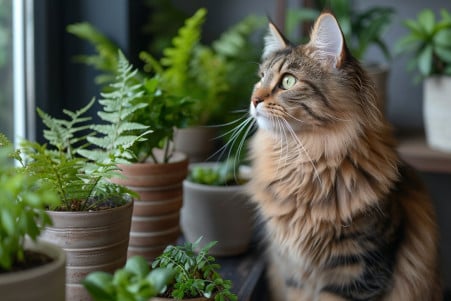Can Dogs Eat Ferns? What Pet Owners Should Know
28 May 2024 • Updated 28 May 2024

Ferns are a beautiful way to bring the outdoors inside, but if you have a dog, you may be concerned about the potential risks of letting your furry friend get too close to these plants. While ferns are not toxic to dogs, so you don't have to worry if your dog eats a few fern fronds or fiddleheads, the fibrous texture can lead to intestinal blockages if your dog eats a lot of them.
In this article, we'll discuss the potential risks associated with ferns by looking at information from veterinary journals and plant databases to determine if there are any ferns that you should keep out of your home if you have a dog. We'll also talk about how to reduce the risk and what to do if your dog shows signs of a problem after eating ferns. With this information, you can make sure that your home is a safe, fern-filled paradise for your faithful friend.
Are ferns toxic to dogs?
Toxic Fern Species and Dog Poisoning Symptoms
Asparagus ferns (also known as emerald ferns, sprengeri ferns, foxtail ferns, and lace ferns) are toxic to dogs and cats. The berries and leaves of asparagus ferns contain sapogenins, which can lead to symptoms like vomiting, diarrhea, abdominal pain, and skin irritation if your dog eats them.
Bracken ferns are another type of fern that can be toxic to a variety of animals, including dogs. Eating bracken ferns can cause thiamine deficiency, which can lead to symptoms such as anorexia, ataxia, and muscle twitching. Ingesting large amounts can cause more serious conditions like enzootic hematuria, bright blindness, and bracken staggers, depending on the animal species.
On the other hand, true ferns like sword fern, button fern, and staghorn fern are generally non-toxic to dogs, according to the ASPCA. While the fibrous nature of ferns could potentially cause intestinal blockages if eaten in large amounts, most ferns are considered low-risk for your dog. Still, it’s important to know which types of ferns are toxic so you can keep your dog out of harm’s way.
First Aid and Treatment of Fern Poisoning in Dogs
If your dog has eaten a poisonous fern, make sure to clear any plant material from their mouth and offer them water, but do not induce vomiting unless you are told to do so by a vet. Puppy Tales blog notes that you should never try to induce vomiting at home, as it can be extremely dangerous.
Look out for signs of distress such as drooling, vomiting, diarrhea, and lethargy, and contact your vet immediately if you notice any of these symptoms. Wag! explains that you should be ready to provide information about your dog's breed, age, weight, symptoms, and the substances they may have been exposed to.
Treatment at the vet's office could include inducing vomiting, giving activated charcoal, IV fluids, and medications to help with symptoms. Australia Wide First Aid explains that in more serious cases of fern poisoning, dogs may need to be hospitalized for observation and supportive treatment.
It's important to act fast and get your dog to the vet as soon as possible to give them the best chance of recovery. Greg blog explains that when it comes to treating fern poisoning in dogs, time is of the essence.
Pet-Safe Alternatives to Poisonous Ferns
For dog parents who still want to enjoy the beauty of plants but don't want to risk their pets' health, there are plenty of safe, dog-friendly alternatives to poisonous ferns. Non-toxic houseplants like Boston ferns, African violets, spider plants, peperomia, and a variety of succulents can still bring color and life into your home without putting your dog in danger.
When you're picking out plants, make sure to do your homework and confirm that the plants you choose are non-toxic to dogs and cats, as some plants may be safe for one species and not the other. Stick to pet-friendly options and take into account things like how easy the plant is to take care of and how much it will grow when you're deciding which plants to bring into your home and around your pets.
By choosing pet-safe plants, you can still enjoy the benefits of having plants in your home while making sure that your dogs stay safe and healthy. This can help you strike a balance and create a low-stress, low-risk situation for both your plants and your furry friends.
How to Train Dogs to Avoid Toxic Plants and Pet-Proof Your Home
In addition to choosing non-toxic plants, training dogs to avoid toxic plants can help keep them safe. Obedience training programs can help dogs learn good habits and reinforce commands like 'leave it' to help prevent them from eating toxic plants.
To pet-proof your home, make sure to keep toxic houseplants out of reach, use physical barriers like chicken wire or thorny branches, and set up play areas for your dog. You can also use natural deterrents like diluted lemon juice or cover soil with foil or stones to keep dogs from digging or chewing in plant areas.
Consistency and positive reinforcement are important when training dogs to stay away from certain areas and plants. With a little effort, you can create a safe, plant-friendly space for your dog and your plants.
Conclusion: How to Keep Your Dog Safe Around Ferns
While most ferns are generally safe for dogs, it's important to know the potential dangers and recognize toxic ferns like asparagus ferns and bracken ferns. If you think your dog has eaten a toxic fern, it's important to act quickly and seek professional veterinary care to ensure the best possible outcome.
To avoid the risk of fern poisoning, opt for dog-friendly alternatives to toxic ferns, such as Boston ferns, African violets, and succulents. You can also train your dog and take other steps to keep them from eating plants and other non-food items.
By learning about the risks, choosing safe plants, and taking other precautions, you can ensure that your houseplants and your pets can coexist safely and happily.


